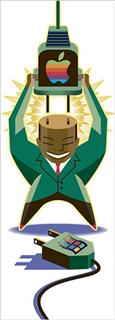 Coming from the PC camp, I can say using a Mac does, indeed, come with some adjustment. But when I got to start playing with a Mac and then using one as my regular machine at the place where I used to work, I was smitten. Everything works seamlessly–or at least that’s the way Macs are designed to be. Ideally you would have an all-in-one solution, unlike PC-based desktops and even laptops, which I sometimes consider to be patchwork. What’s great with Macs is that the software is designed to work with the hardware in a seamless fashion, and it’s the same the other way around.
Coming from the PC camp, I can say using a Mac does, indeed, come with some adjustment. But when I got to start playing with a Mac and then using one as my regular machine at the place where I used to work, I was smitten. Everything works seamlessly–or at least that’s the way Macs are designed to be. Ideally you would have an all-in-one solution, unlike PC-based desktops and even laptops, which I sometimes consider to be patchwork. What’s great with Macs is that the software is designed to work with the hardware in a seamless fashion, and it’s the same the other way around.
I came across an article on the NY Times where the writer explains why switching from PC to Mac today has become an easier choice than it was a few years ago.
Today the calculation is different. Apple Computer, through a series of transitions, has reinvented itself. With a new operating system, its own chain of retail stores, the iPod and now a new line of computers that run on Intel processors, this new and more mainstream Apple is catching the attention of Windows users, and many are curious about switching.
In terms of the software, I agree that there was a learning curve when I first tried working out on Mac OS X. Keys and commands were different. Heck, even the mouse/cursor was different–there was only one button, when I was used to my Windows machine, which typically had at least two buttons.
Admittedly, though, the Mac’s design, hardware- and software-wise was supposed to be more intuitive, particularly if your first experience with computers was with a Mac. It’s just so easy. There were no confusions with which button to click (as there was only one), and the software was pleasingly easy to understand.
However, it’s usually the hardware factor that’s the first thing to impress people when it comes to Mac computers. With the exception of some high-end, high-performance machines, PC desktops and notebooks are usually the same old boring thing. Mac desktops and notebooks are different in that they spell out s-e-x-y. Whether it’s an old vintage Powerbook or the latest MacBook Pro, you know you have a machine whose design is well-thought of (in terms of aesthetics and performance).
With Apple’s switching to the Intel x86 platform, I can see some form of convergence down the road. This will surely attract those from the other side of the fence to switch over to their side, or at least try out Macs. Somehow, this will be risk-free, since people can use Windows anytime (albeit not cost-wise, since Macs are definitely more expensive than most PC hardware). One question remains, though: will Apple eventually sell their famed Mac OS X separately from the hardware, such that these can be installed on PCs? That’s something hotly debated even until today. But it’s probably not a distant possibility.